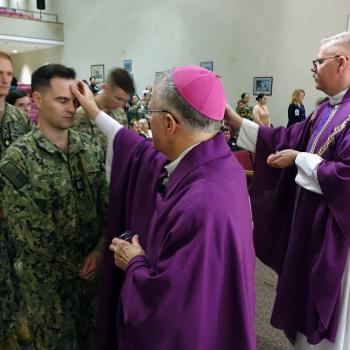 Now and again as I work and perform my chores I hear a faint jingle from the small cross and miraculous medal I wear around my neck. Some people see them as nothing more than jewelry, nice charms on a gold chain. To me, they are cues to my identity as a Christian, one with a particular devotion to the Blessed Mother.
Now and again as I work and perform my chores I hear a faint jingle from the small cross and miraculous medal I wear around my neck. Some people see them as nothing more than jewelry, nice charms on a gold chain. To me, they are cues to my identity as a Christian, one with a particular devotion to the Blessed Mother.
Both the gold cross and the medal were gifts from my husband on different occasions over the years. But the one sacramental I cherish the most is my wedding band on my left hand. (Wedding bands are so commonplace that we almost forget that they really are sacramentals that point to a unique sacrament and a sacred duty!) My band not only carries the blessing from my wedding day, but it enlivens my every day with a consciousness of the vows of my vocation.
All these tangible, wearable sacramentals are outward signs that remind me who I am and whose I am. They bring my faith, hope, and love alive.
Despite their name, sacramentals are not sacraments. Nor are they lucky charms or magical talismans. I harbor no superstitions about them, as no powers accompany them. Yet they do reflect all the special graces I have already received, pointing to the gift of God's on-going presence in my life.
A sacrament actually confers grace that comes directly from Christ. If the sacraments are the big-ticket events—the most important moments of grace in the lives of Catholics—then sacramentals might be happily referred to as the small change of the sacraments. They do not confer any grace in and of themselves, but they prepare us to receive the fruit of the sacraments. They sanctify our daily lives.
Sacramentals illuminate the sacred in every day. Given to us by the Church in the service of the sacraments, they remind us of the graces we hold dear, and the God who holds us near. They dispose us to divine life found in daily life, like loving tokens of friendship between God, the communion of saints, and us.
Popular piety surrounding sacramentals, when properly aligned with the faith of the Church, help us grow in our devotion to God.
These sacramentals . . . are as integral to an incarnational-bodily Christianity as are the seven sacraments. Not just optional "add-ons," they are essential to experiencing the world through Catholic eyes and, even more importantly, with a Catholic heart. All creation speaks to us of God. Times and seasons will have their place in our devotion, since we are beings who live in history. Spaces, places, and special clothing are indispensible. That's why we build cathedrals, set aside sanctuary areas, wear religious habits, and buy our children First Communion outfits.
Material objects and blessings enfold Catholic life as reminders of the mysteries of creation and redemption. "There is hardly any proper use of material things," declared Vatican II, "which cannot thus be directed toward the sanctification of men and women and the praise of God." The variety of sacramentals is endless: blessing fields, walking the Way of the Cross, saying Rosaries, venerating crucifixes and statues in churches and homes. (Most Rev. J. Michael Miller, "Sacramentals in Catholic Theology," The How-to Book of Sacramentals, Ann Ball, Our Sunday Visitor, 2005)
The Catechism of the Catholic Church, while not keeping a finite or exacting inventory, also lists these sacramentals flowing from the life of grace in the Church: veneration of relics, visits to sanctuaries, pilgrimages, processions, the stations of the cross, religious dances, the rosary, medals, etc.
These expressions of piety extend the liturgical life of the Church, but do not replace it. They should . . . harmonize with the liturgical seasons, accord with the sacred liturgy, are in some way derived from it and lead the people to it, since in fact the liturgy by its very nature is far superior to any of them. (Catechism of the Catholic Church, par. 1675)
Sacramentals come in many forms, some universal and some more distinctive to certain cultures found within the Universal Church. Over the years, I've walked in rosary processions at Fátima, and witnessed pilgrims from different nations praying the Angelus at St. Peter's Square in Rome. I've collected holy cards from the funerals of precious relatives and friends, and lit candles in front of Russian icons for special intentions. I've knelt before backyard shrines to saints, prayed laps around chaplets, and tasted ethnic foods that commemorate feasts within the liturgical calendar.
All these sacramentals—the devotional and traditional practices, sacred objects, and blessings—let faith and life comingle naturally. They bring reasons for joy and celebration even in our most difficult moments, keeping the spiritual life grounded and familiar and real. They touch my human sensibilities, and give me small ways to share in the life of the Church from my little corner of the world.
(Speaking of sacramentals, this article posts on February 3rd, the feast day of St. Blaise. Most churches will offer a sacramental blessing of the throats today with a prayer and candles, in honor of St. Blaise.)
2/3/2011 5:00:00 AM





